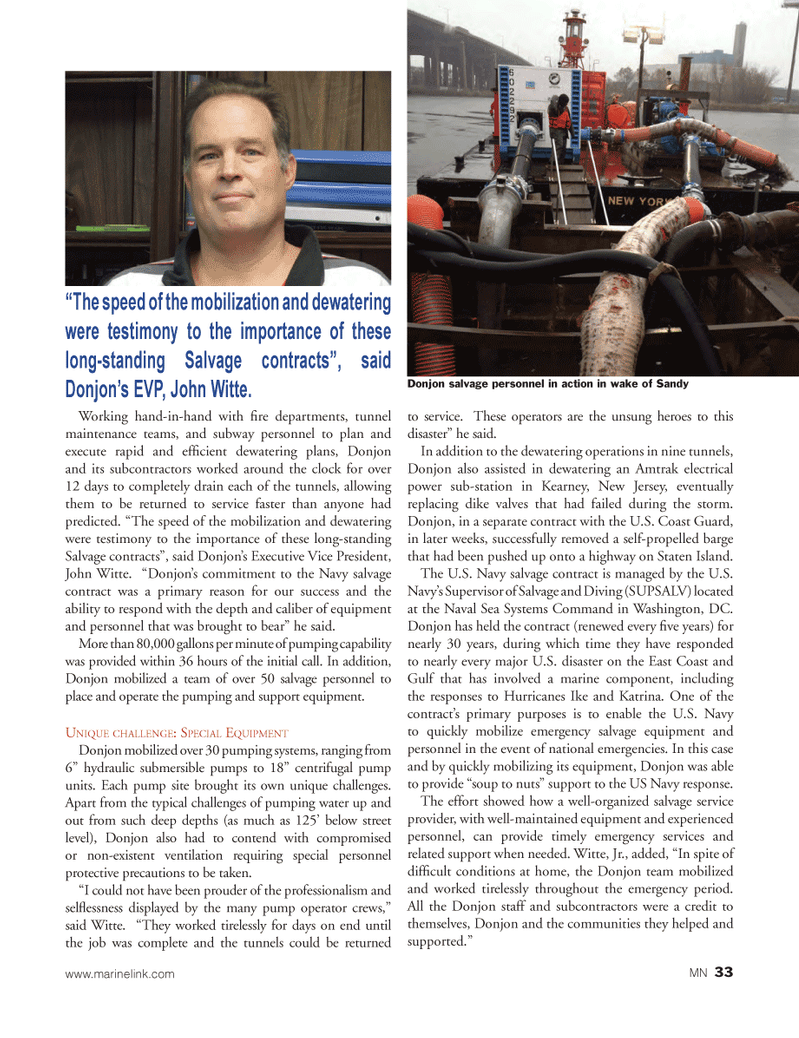
Page 33: of Marine News Magazine (January 2013)
Training and Education
Read this page in Pdf, Flash or Html5 edition of January 2013 Marine News Magazine
Working hand-in-hand with Þ re departments, tunnel maintenance teams, and subway personnel to plan and execute rapid and efÞ cient dewatering plans, Donjon and its subcontractors worked around the clock for over 12 days to completely drain each of the tunnels, allowing them to be returned to service faster than anyone had predicted. ÒThe speed of the mobilization and dewatering were testimony to the importance of these long-standing Salvage contractsÓ, said DonjonÕs Executive Vice President, John Witte. ÒDonjonÕs commitment to the Navy salvage contract was a primary reason for our success and the ability to respond with the depth and caliber of equipment and personnel that was brought to bearÓ he said. More than 80,000 gallons per minute of pumping capability was provided within 36 hours of the initial call. In addition, Donjon mobilized a team of over 50 salvage personnel to place and operate the pumping and support equipment. UNIQUE CHALLENGE: SPECIAL EQUIPMENT Donjon mobilized over 30 pumping systems, ranging from 6Ó hydraulic submersible pumps to 18Ó centrifugal pump units. Each pump site brought its own unique challenges. Apart from the typical challenges of pumping water up and out from such deep depths (as much as 125Õ below street level), Donjon also had to contend with compromised or non-existent ventilation requiring special personnel protective precautions to be taken. ÒI could not have been prouder of the professionalism and selß essness displayed by the many pump operator crews,Ó said Witte. ÒThey worked tirelessly for days on end until the job was complete and the tunnels could be returned to service. These operators are the unsung heroes to this disasterÓ he said. In addition to the dewatering operations in nine tunnels, Donjon also assisted in dewatering an Amtrak electrical power sub-station in Kearney, New Jersey, eventually replacing dike valves that had failed during the storm. Donjon, in a separate contract with the U.S. Coast Guard, in later weeks, successfully removed a self-propelled barge that had been pushed up onto a highway on Staten Island. The U.S. Navy salvage contract is managed by the U.S. NavyÕs Supervisor of Salvage and Diving (SUPSALV) located at the Naval Sea Systems Command in Washington, DC. Donjon has held the contract (renewed every Þ ve years) for nearly 30 years, during which time they have responded to nearly every major U.S. disaster on the East Coast and Gulf that has involved a marine component, including the responses to Hurricanes Ike and Katrina. One of the contractÕs primary purposes is to enable the U.S. Navy to quickly mobilize emergency salvage equipment and personnel in the event of national emergencies. In this case and by quickly mobilizing its equipment, Donjon was able to provide Òsoup to nutsÓ support to the US Navy response. The effort showed how a well-organized salvage service provider, with well-maintained equipment and experienced personnel, can provide timely emergency services and related support when needed. Witte, Jr., added, ÒIn spite of difÞ cult conditions at home, the Donjon team mobilized and worked tirelessly throughout the emergency period. All the Donjon staff and subcontractors were a credit to themselves, Donjon and the communities they helped and supported.Ó Donjon salvage personnel in action in wake of Sandy?The speed of the mobilization and dewatering were testimony to the importance of these long-standing Salvage contracts?, said Donjon?s EVP, John Witte. www.marinelink.com MN 33MN Jan2013 Layout 32-42.indd 33MN Jan2013 Layout 32-42.indd 331/2/2013 2:29:40 PM1/2/2013 2:29:40 PM

 32
32

 34
34
